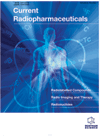- Home
- A-Z Publications
- Current Radiopharmaceuticals
- Previous Issues
- Volume 16, Issue 3, 2023
Current Radiopharmaceuticals - Volume 16, Issue 3, 2023
Volume 16, Issue 3, 2023
-
-
Promising Radiopharmaceutical Tracers for Detection of Cardiotoxicity in Cardio-oncology
More LessCancer treatment has the potential to cause cardiovascular issues and can encourage the appearance of all aspects of cardiac disease, including coronary heart disease, myocardial disease, heart failure, structural heart disease, and rhythm problems. Imaging is required for both diagnostic workup and therapy monitoring for all possible cardiovascular side effects of cancer therapy. Echocardiography is the cardiac imaging g Read More
-
-
-
Cardiac Injury Following Chemo/Radiation Therapy: An Updated Review on Mechanisms and Therapeutic Approaches
More LessCardiovascular disorders are among the critical side effects of cancer therapy. Damage to the function and normal structure of the heart can cause serious threats to patients that are being treated for cancer. Cardiovascular complications may be induced by various types of chemotherapy drugs and also radiation therapy. The severity of cardiovascular toxicity depends on several factors, such as types of drugs, tumor location for Read More
-
-
-
Gamma Knife Radiosurgery Modulates micro-RNA Levels in Patients with Brain Metastasis
More LessBackground: The relation between micro-RNA (miRNA) modulation and immune cell activity in high-dose radiation settings is not clearly understood. Objective: To investigate the role of stereotactic radiosurgery (SRS) in (i) the regulation of tumorsuppressor and oncogenic miRNAs as well as (ii) its effect on specific immune cell subsets in patients with metastatic brain tumors (MBT). Methods: 9 MBT patients who under Read More
-
-
-
An In-House 3D Voxel Dosimetric Tool to Compare Predictive and Post- Treatment Dosimetry in 90Y Radioembolization: A Proof of Concept
More LessAuthors: Ornella Ferrando, Rossana Bampi, Franca Foppiano and Andrea CiarmielloAim: The aim of this study was to implement an in-house dosimetric tool to assess tumour- absorbed doses in pre and post-dosimetry for 90Y radioembolization with resin spheres. Materials and Methods: To perform dosimetric calculations we set up a dosimetric procedure and developed homemade software to calculate tumour absorbed dose and dose volume histograms (DVHs). The method is based on a simplified voxel Read More
-
-
-
A Computed Tomography-based Radiomics Analysis of Low-energy Proximal Femur Fractures in the Elderly Patients
More LessIntroduction: Low-energy proximal femur fractures in elderly patients result from factors, like osteoporosis and falls. These fractures impose high rates of economic and social costs. In this study, we aimed to build predictive models by applying machine learning (ML) methods on radiomics features to predict low-energy proximal femur fractures. Methods: Computed tomography scans of 40 patients (mean ± standard devia Read More
-
-
-
DTPA(DOTA)-Nimotuzumab Radiolabeling with Generator-produced Thorium for Radioimmunotherapy of EGFR-overexpressing Carcinomas
More LessIntroduction: The feasibility of preparing the “in-house” generators and the Th- DTPA(DOTA)-Nimotuzumab radioimmunoconjugate was evaluated. 226Th is perspective for TAT, however, due to short half-life it is preferable to apply this radionuclide for readily available epithelial malignancies. Nimotuzumab being specific for EGFR expressing cells as a targeting moiety is considered to be suitable for thorium delivery. Methods: T Read More
-
-
-
World’s First Experience of the Low-Dose Radionuclide Inhalation Therapy in the Treatment of COVID-19-Associated Viral Pneumonia: Phase 1/2 Clinical Trial
More LessAuthors: Peter Shegay, Alexey Leontyev, Denis Baranovskii, German Davydov, Marina Poluektova, Lyudmila Grivtsova, Vasily Petriev, Valeriy Stepanenko, Igor Gulidov, Valeriy Krylov, Svetlana Osadchaya, Vladimir Petrov, Maria Sedova, Mikhail Vekilyan, Olga Krasilnikova, Sergey Morozov, Sergey Ivanov, Ilya Klabukov and Andrey KaprinObjective: Previously, low-dose radiation therapy was used for pneumonia treatment. We aimed to investigate the safety and effectiveness of carbon nanoparticles labeled with Technetium isotope (99mTc) in a form of ultradispersed aerosol in combination with standard COVID-19 therapy. The study was a randomized phase 1 and phase 2 clinical trial of low-dose radionuclide inhalation therapy for patients with COVID-19 rel Read More
-
Most Read This Month
Article
content/journals/crp
Journal
10
5
false
en


